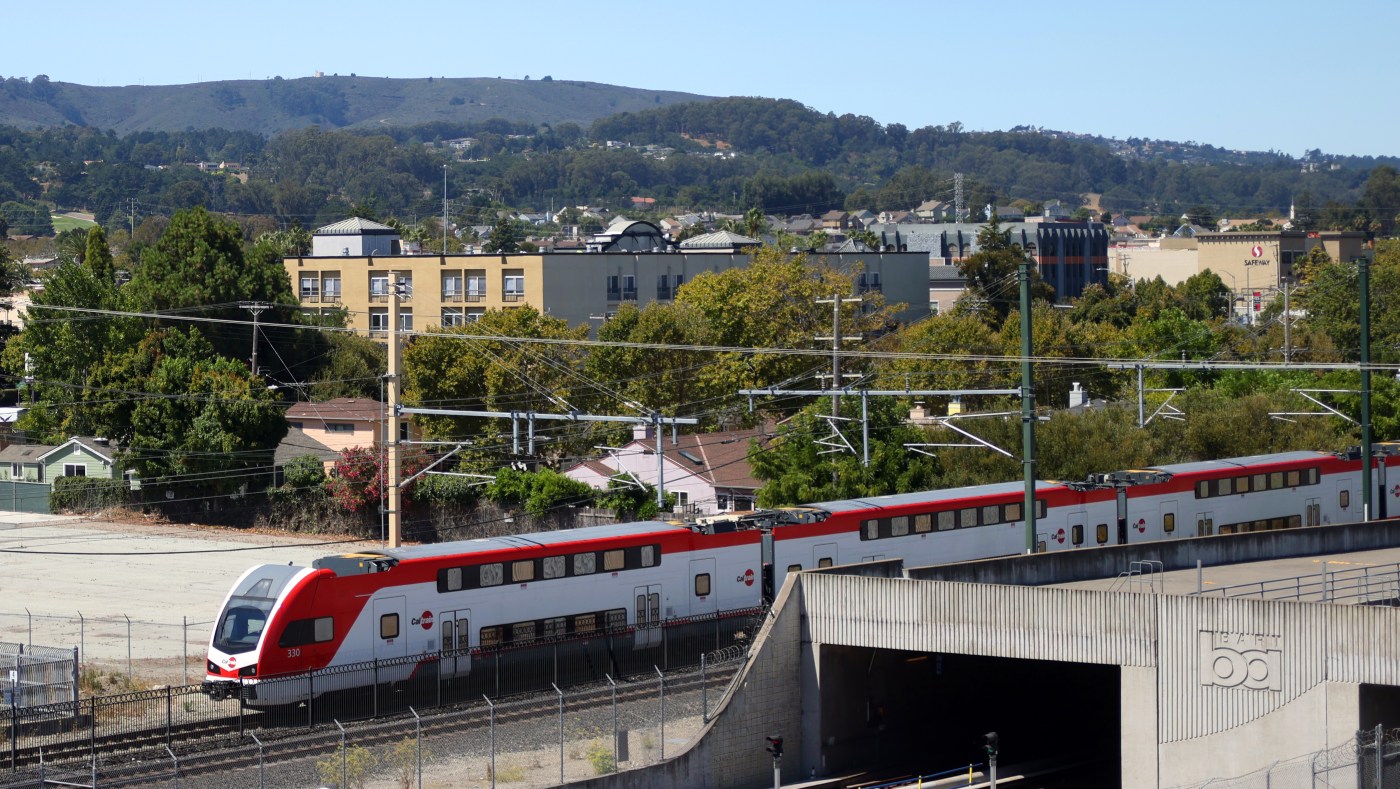San Mateo County officials are clashing with the state lawmakers over a proposed regional sales tax that would bail out the Bay Area’s distressed transit systems, arguing that their constituents would shoulder an outsized share of the burden without a fair say in how the money is spent.
The debate has complicated negotiations around the bill, SB 63, which would allow voters to impose a half-cent sales tax in Alameda, Contra Costa, San Mateo and Santa Clara counties, and a full cent in San Francisco. The tax could raise up to $1 billion annually over the next 14 years for BART, Caltrain, San Francisco’s Muni and other agencies facing steep budget gaps as federal and state relief funds dry up.
A SamTrans bus exits the Millbrae Transit Center on Tuesday, Sept. 2, 2025, in Millbrae. San Mateo County officials are clashing with the state lawmakers over a proposed regional sales tax that would bail out the Bay Area’s distressed transit systems. (Aric Crabb/Bay Area News Group)
At issue is San Mateo County’s lack of representation on BART’s board, which is made up of elected representatives from San Francisco, Alameda County and Contra Costa County. Together, the three county’s residents pay some $392 million in sales and property taxes toward the system, which make up nearly 40% of its total operating revenue. Meanwhile, San Mateo County contributes just $4 million annually.
If voters pass the measure, San Mateo residents could be on the hook for roughly $35 million a year, about 10 percent of the sales tax revenue earmarked for BART. Yet without some kind of representation on the board, Assemblymember Diane Papan and Supervisors Jackie Speier and Ray Mueller say the measure amounts to taxation without representation. They are advocating for amendments to give San Mateo more leverage, including the ability to withhold funds from BART if county officials believe they are being misused.
“When I’m asking my community to dig into their pockets — and this is a very regressive tax — we’re going to get a good deal for the people we’re asking for the money from,” Papan said in a Board of Supervisors meeting last week.
Getting more leverage over BART is politically fraught. The board is composed of labor union allies, who have resisted diluting its power. The board has also been accused of resisting oversight in the past.
A passenger walks along a BART platform at the Millbrae Transit Center on Tuesday, Sept. 2, 2025, in Millbrae, Calif. A group of San Mateo County elected officials are raising a fuss over a proposed regional sales tax meant to bail out the Bay Area’s distressed public transportation system. (Aric Crabb/Bay Area News Group)
With SB 63, the Legislature would create a special district made up of participating counties that would be governed by the Metropolitan Transportation Commission, the Bay Area’s regional planning body. The sales tax could be placed on the ballot either through an action of the commission or through a qualified citizens’ initiative. The bill’s sponsors are hoping to take the latter route, as it would require a simple majority to pass, versus a two-thirds vote if placed on the ballot by MTC. Polling has shown that 54% of voters across Alameda, Contra Costa and San Mateo would vote yes on such a measure.
The bill, which has the support of major business groups, is expected to pass in some form — but San Mateo County’s last-minute wrangling over the bill could result in less of the dollars generated in the county going toward BART.
Sen. Scott Wiener, who authored the bill with fellow Democrat Jesse Arreguín, said that some transit advocates have long felt that San Mateo County has not paid enough toward the agency, which has six stations in the county.
San Mateo County’s lack of representation within BART is also self-inflicted — to be represented, they would need to be a part of the BART district, which levies a property tax across its member counties. In 1957, San Mateo County opted into the formation of the original district, but supervisors pulled out in 1962 before construction began, citing BART’s redundancy with the planned Caltrain line and concerns about higher taxes. They were also under pressure from David Bohannon, owner of the Hillsdale Shopping Center, who worried that BART would facilitate easier access to retail in San Francisco.
The sales tax oversight committee that Papan is pushing for would be a way around the lack of representation. But transit advocates like Wiener say that giving one county veto power could undermine the measure’s regional approach.
“There are times where one county pays a bit more, but we’re ultimately all integrated as one region,” he said.
Passengers wait to board a train from the East Bay at the Embarcadero BART station in San Francisco on Thursday, Oct. 3, 2024. (Ray Chavez/Bay Area News Group)
Wiener’s bill, three years in the making, comes as the Bay Area’s transportation services warn of deep service cuts starting in 2026 without new funding. BART anticipates a $378 million shortfall in fiscal year 2027, while Caltrain projects a $65 million deficit. Two of Wiener’s previous proposals to cover the funding gaps faced serious pushback: A new bridge toll was seen as too costly to drivers, and a nine-county regional ballot measure included a study that could have put the region on a path to consolidating some of the region’s 27 transit agencies, which would have threatened the power of each agency’s individual board.
Labor groups had argued that the bailout should come in the form of a gross receipts tax on Bay Area corporations. But business groups said they would fight such a tax, and lobbied instead for a regional sales measure.
As is often the case for regional measures, questions of local control have loomed over SB 63. Supervisors Mueller and Speier are weighing whether supporting a regional tax could jeopardize their own future local measures for child care or fire protection. They proposed passing their own countywide measure to fund Caltrain’s deficit.
Commuters are reflected in a window of a Caltrain at the Diridon Station transportation hub on Monday, March 10, 2025, in San Jose. (Aric Crabb/Bay Area News Group)
Meanwhile, critics of BART’s management say the board should have taken steps to fill its funding gap, like layoffs or renegotiating its contracts with labor, before turning to voters. Since 2019, BART’s operating budget has increased nearly 20% to $1.1 billion from $921 million, about the same pace as inflation. Its workforce is about the same size as it was in 2019.
“BART has grown their staff and operations and not undertaken any serious fiscal right-sizing that avoids these revenue shortfalls,” said former State Sen. Steve Glazer, an Orinda Democrat who has called for greater oversight of the agency. “How can we have confidence in them when they’re saying that the only alternative is to come to taxpayers and ask for more money?”





